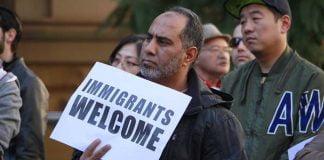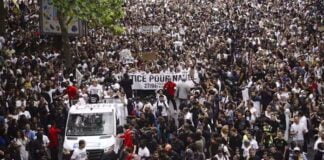India is being rocked by protests and strikes against hard right Prime Minister Narendra Modi.
On 8 January 250 million workers joined a general strike against labour law reforms. As many as one in five workers stopped work, according to some unions. An economic slowdown has led to a surge in unemployment, and plans for privatisation of state-owned airlines, banks, and mining companies will mean further job losses.
Recent months have also seen mass protests against legislation designed to deny thousands of Muslim and Tamil refugees Indian citizenship.
Tens of thousands have defied bans on demonstrations, and police have shot dead around 25 people.
The Citizenship Amendment Act (CAA) would allow migrants from Bangladesh, Pakistan and Afghanistan to apply for citizenship—unless they are Muslim. There are 200 million Muslims living inside India, around 15 per cent of the population.
There is also anger regarding the National Register of Citizens (NRC) legislation which requires people to produce documents of ancestry to be enlisted as Indian citizens. When the ruling Bharatiya Janata Party (BJP) implemented this in Assam state in 2015 they said it was meant to “throw out infiltrators.” Now Modi wants to implement it nationally.
The BJP’s neo-liberal policies have made India’s rich and middle classes even more wealthy. But more than 20 per cent of Indians live below the official poverty line despite years of economic growth.
Last year Narendra Modi and the BJP swept back to power in an election landslide.
The opposition Indian National Congress vote collapsed.
Congress led the anti-colonial struggle against Britain. It has lived off the prestige of Congress leaders like Mahatma Gandhi who fought for independence. It also collaborated in partitioning the country along communal lines into India and Pakistan. Two million people died in the resulting crisis. The contested state of Jammu and Kashmir remains under Indian military occupation.
After independence in 1947, Congress pursued state-led capitalist development and social welfare. But following the global economic downturn of the 1970s, Congress turned to neo-liberal economic policies.
It also encouraged communalism to divide and rule. In 1984 Congress Prime Minister Indira Gandhi ordered a military assault on the most significant religious centre for Sikhs, Darbar Sahib (the Golden Temple) in Amritsar, Punjab. The attack killed thousands of civilians. Gandhi was later assassinated by two of her Sikh bodyguards, triggering riots in which 20,000 Sikhs were massacred. Subsequent Congress governments were increasingly authoritarian, corrupt, and unpopular.
The BJP has filled the vacuum as the preferred party of Indian capital. It has pursued neo-liberal policies and allied with the US war on terror as cover for increased Islamophobia and repression of the left.
The BJP is the electoral wing of the Rashtriya Swayamsevak Sangh (RSS). The RSS is a fascist organisation. It champions Hindutva, a far right version of Hindu nationalism. RSS leaders have advocated forced sterilisation of Muslims and have repeatedly organised communal violence, including the 2002 Gujarat riots in which 1000 Muslims were massacred.
Modi is a long standing member of the RSS and presided over the Gujarat riots as Chief Minister of the state. The RSS claims five million members, organised in 60,000 branches which provide ideological and also firearms training.
The RSS has street fighters with a record of mass murder and the BJP now has a majority in parliament.
But for the moment India’s ruling class does not require fascism to ensure its rule. The economic crisis is not deep enough, nor resistance to it from workers strong enough, for India’s bosses to feel sufficiently threatened. Economically Modi is pursuing the same neo-liberal attacks on workers as governments everywhere.
A previous BJP government was thrown out after one term in 2004 over anger at its failure to improve ordinary people’s lives. Modi’s recent legislative attacks on Muslims are a signal to RSS members that he remains committed to their extreme Hindu nationalism, and a way of diverting attention from his neo-liberalism.
The experience of fascist parties in Europe that have entered government, like the National Alliance (AN) in Italy and the Freedom Party in Austria, show the tensions he faces.
The AN’s leader, Gianfranco Fini, became deputy prime minister in a coalition government with Silvio Berlusconi’s Forza Italia in 2001, and declared himself “post-fascist” and loyal to parliamentary democracy. This was too much for many AN members who eventually resigned.
Both of India’s Communist parties were nearly wiped out in the election due to their record of implementing neo-liberal policies at local and state government level. The armed struggle in rural areas faces increasing repression from the military.
But the recent strikes and protests are an opportunity for the left to break out of the dead ends of electoralism and armed struggle—and build a more powerful resistance against Modi and the BJP, and the system they represent.
By Michael Douglas





